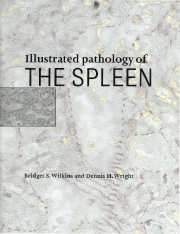Book contents
- Frontmatter
- Contents
- Preface
- Acknowledgements
- 1 Introduction
- 2 Normal structure, development and functions of the spleen
- 3 Post-traumatic and incidentally removed spleens
- 4 The spleen in hereditary blood cell abnormalities and auto-immune disorders
- 5 The spleen in immunodeficiency and systemic infections
- 6 Lymphomas involving the spleen
- 7 The spleen in myeloproliferative disorders
- 8 Pathology of the splenic stroma
- 9 Metastases and miscellaneous conditions
- 10 Summary: some key points in splenic differential diagnosis
- Index
4 - The spleen in hereditary blood cell abnormalities and auto-immune disorders
Published online by Cambridge University Press: 14 August 2009
- Frontmatter
- Contents
- Preface
- Acknowledgements
- 1 Introduction
- 2 Normal structure, development and functions of the spleen
- 3 Post-traumatic and incidentally removed spleens
- 4 The spleen in hereditary blood cell abnormalities and auto-immune disorders
- 5 The spleen in immunodeficiency and systemic infections
- 6 Lymphomas involving the spleen
- 7 The spleen in myeloproliferative disorders
- 8 Pathology of the splenic stroma
- 9 Metastases and miscellaneous conditions
- 10 Summary: some key points in splenic differential diagnosis
- Index
Summary
Introduction
Although primary splenic pathology is uncommon underlying disorders in which the spleen is responsible for excessive destruction of blood cells, splenectomy may be performed for control of symptoms (usually anaemia and/or thrombocytopenia). The spleen in such conditions is usually modestly enlarged, up to twice or three times normal weight. Only rarely is major splenomegaly of 1000 g or more the cause for removal.
Excessive red blood cell destruction occurs in dyserythropoietic states such as hereditary spherocytosis (HS), hereditary elliptocytosis (HE), various inherited red cell enzyme deficiencies, sickle cell disease and thalassaemias. In these conditions, mechanically or metabolically abnormal red blood cells are removed prematurely from the circulation by splenic sequestration.
In auto-immune haemolytic anaemia (AIHA) and idiopathic thrombocytopenia (ITP), antibody-coated red cells and platelets are phagocytosed by splenic macrophages. Occasionally auto-immune red cell and platelet destruction occur together in the same patient; this combination is sometimes referred to as Evans' syndrome.
Variable cytopenias may also occur in association with splenic enlargement from any cause, although the mechanisms underlying hypersplenism in splenomegaly are often unclear.
Vaccination before splenectomy
In recent years, pre-splenectomy vaccination against Streptococcus pneumoniae, type B Haemophilus influenzae and Neisseria meningitidis groups A and C has been introduced into routine surgical practice (Mayon-White, 1994). It is likely that inoculation against N. meningitidis group B will also be undertaken in future, once an appropriate vaccine becomes available.
- Type
- Chapter
- Information
- Illustrated Pathology of the Spleen , pp. 47 - 62Publisher: Cambridge University PressPrint publication year: 2000



